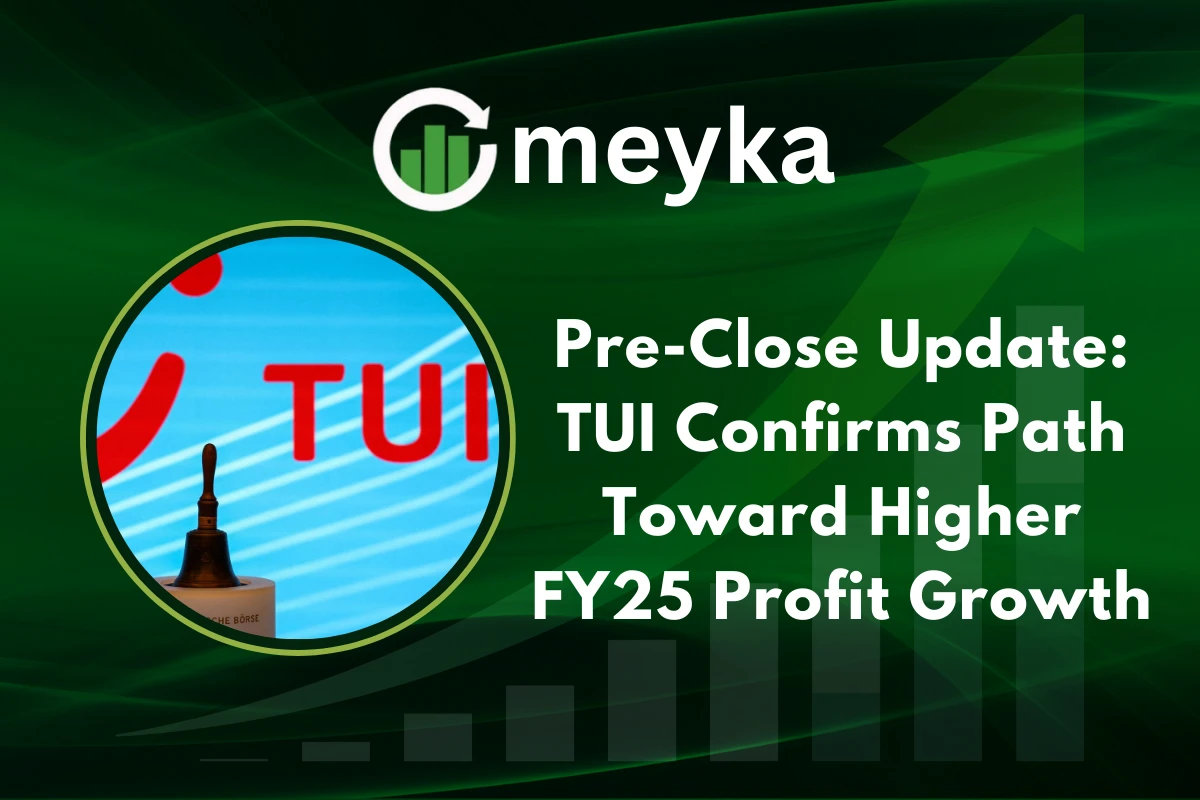Pre-Close Update: TUI Confirms Path Toward Higher FY25 Profit Growth
TUI, Europe’s largest leisure travel company, issued a pre-close trading update that reaffirms a raised FY25 earnings outlook and signals a clear path to higher profit growth. Management told investors that summer trading momentum, strong hotel occupancy, and a positive start to the winter season position the group to deliver underlying EBIT growth of +9-11% in FY25.
The update also flagged improved revenue expectations and a modest improvement in net debt, underpinning confidence in the business plan.
Why is TUI focusing on FY25 profit growth? Management aims to convert resilient demand and higher average selling prices into margin gains while scaling higher-margin businesses like hotels and cruises.
TUI Raises FY25 Guidance and Confirms Financial Targets
The numbers investors care about
TUI’s pre-close update reconfirmed its raised FY25 guidance at constant currency. The company now expects revenue to rise in the lower end of +5-10% and underlying EBIT to grow by +9-11%, upgraded from the prior +7-10% range. TUI also flagged a slight improvement in net debt versus FY24, which points to steady balance-sheet progress.
Why this matters for shareholders
Raised guidance signals operational leverage returning across the group. Hotels & Resorts and Cruises, which command higher margins, drove much of the upgrade, while Markets + Airline held pricing despite softer volumes. That mix supports both short-term cash flow and mid-term margin expansion.
What does this mean for investors? It reduces near-term downside to earnings and improves the outlook for dividends and deleveraging if the trends persist.
TUI Winter Travel Season and Booking Momentum
Early winter bookings and season mix
TUI reported a positive start to Winter 2025/26, with 1.8 million bookings taken to date and winter bookings overall tracking +1%. Short and medium-haul destinations such as the Canaries, Egypt, and the Balearics are performing well, while long-haul demand is led by Mexico and the Dominican Republic. These patterns help smooth revenue into the second half of the fiscal year.
Summer trading remained resilient
Over the summer, TUI added around 1.4 million bookings, bringing season bookings to 14.1 million. While airline volumes were -2% overall, and down -5% in Germany, average selling price (ASP) held +3%, helping to offset volume weakness and protect margins.
Why are winter bookings a critical indicator? Early winter demand signals consumer confidence and secures revenue and cash flow for the traditionally important second half of the financial year.
TUI Underlying EBIT Performance and Margin Drivers
Hotels, cruises and experiences lead performance
TUI highlighted strong occupancy and rising average daily rates in its Hotels & Resorts division. Cruise capacity expanded with new ship deployments and fewer dry dock days, increasing available passenger cruise days significantly for Q4 and H1 FY26.
TUI also expects its Tours & Activities and transfers businesses to grow at mid-single-digit rates, adding higher-margin revenue streams.
Asset-right strategy and cost discipline
The group emphasised an asset-right growth strategy that blends owned, leased, and third-party inventory. This balance helps manage capital intensity and adds flexibility, which is important when aviation and energy costs can pressure margins. Cost control and capacity discipline remain central to preserving the raised EBIT outlook.
How does this protect profits? By focusing on higher-yield inventory and tightening operating efficiency, TUI aims to convert bookings into sustainable margin gains.
TUI Market and Investor Reaction
Shares and sentiment
Markets reacted positively to the pre-close update. Reuters reported that TUI shares rose about 2.5% in early trading after the announcement, a sign that investors welcomed confirmation that guidance remains on track despite macro and geopolitical headwinds.
Analyst takeaways
Analysts see the update as confirmation that TUI’s post-pandemic recovery is durable. The blend of rising ASPs, disciplined capacity expansion, and stronger hotels/cruises is cited as core to a more stable earnings profile for FY25. Trading commentary echoed the view that the update reduces execution risk heading into the full-year results.
How should investors read this update? Treat it as a positive checkpoint confirming strategy execution, while keeping an eye on geopolitical, energy and travel-cost risks that could affect bookings and margins.
TUI Strategy and Mid-Term Ambitions
Growth roadmap and financial targets
TUI reaffirmed clear mid-term ambitions: to generate c. +7-10% CAGR underlying EBIT, to target net leverage strongly below 1.0x, and to return to pre-pandemic rating levels through disciplined growth and deleveraging. The strategy focuses on unlocking shareholder value via margin improvement and selective capacity expansion.
Strategic alliance and capital moves
A standout item in the update was TUI’s strategic alliance with Oman’s OMRAN Group to develop a cluster of five new hotels in Dhofar. OMRAN will become a 1.4% strategic shareholder, acquiring newly issued shares at €9.50 each. The deal signals targeted, asset-light expansion funded through partnership rather than heavy balance-sheet investment.
What does the OMRAN deal signal? It demonstrates TUI’s willingness to use strategic partnerships to accelerate growth in attractive regions while limiting leverage.
TUI Implications for the European Travel Market and Competitors
Market positioning and resilience
TUI’s scale across Europe, including strong footprints in the UK, Germany, Spain, and beyond, gives it competitive advantages in procurement and distribution. Its integrated model of airlines, hotels, and cruises creates cross-sell opportunities and resilience when single segments face pressure.
What competitors must watch?
Rivals and OTAs will watch occupancy and ASP trends closely. If TUI’s asset-right strategy and product differentiation continue to lift margins, competitors may need to match capacity discipline and enhance product appeal to defend market share.
Is Europe’s travel recovery secure? TUI’s update is encouraging, but recovery remains sensitive to broader economic and geopolitical developments that can shift travel demand quickly.
Conclusion
TUI’s pre-close trading update offers a fact-based signal that the group is on track to deliver higher FY25 profit growth. The raised underlying EBIT guidance, solid booking momentum into winter, and strategic moves such as the OMRAN partnership create a credible roadmap for improved earnings and balance-sheet resilience.
For investors and industry watchers, the update validates recent strategy while reminding all stakeholders that execution and external risks will determine whether this positive momentum is sustained into FY26.
FAQ’S
TUI’s growth strategy focuses on expanding its travel and tourism services, improving digital platforms, and increasing efficiency to secure long-term profitability.
Yes, TUI has returned to profitability with improved earnings from its strong summer travel bookings and cost management strategies.
TUI expects higher FY25 profit growth, supported by strong winter bookings, robust demand for holidays, and an increase in underlying EBIT performance.
The four types of growth strategies are market penetration, market development, product development, and diversification. TUI applies a mix of these to grow in the travel sector.
While TUI faced challenges during the pandemic, it has significantly recovered, boosted by high demand for travel and strong forward bookings in 2024–2025.
TUI Group is a publicly listed company headquartered in Germany, with shares traded on the London Stock Exchange and Frankfurt Stock Exchange.
The future of TUI looks positive, with a focus on digital transformation, sustainable travel solutions, and consistent growth in holiday demand across Europe.
Disclaimer
This content is for informational purposes only and not financial advice. Always conduct your research.






